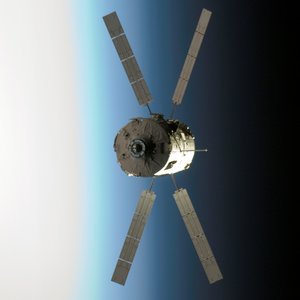Jules Verne manuscripts
Jules Verne, who passed away in 1905, never lived to see any of his imagined voyages come true, but thanks to a new European spacecraft bearing his name, his original notes will have travelled – by their return to Earth in November 2008 (with a Space Shuttle) – about 150 million kilometres, further than some of the times and distances documented by Jules Verne.
Whereas Verne estimated it would take nine months to cover the quarter of a million miles to the Moon by his fastest available mode of transportation - the locomotive - the ESA's Automated Transfer Vehicle (ATV) covered the equivalent distance during its first day in orbit following its launch on 9 March 2008 on an Ariane rocket from Kourou, French Guiana.
"After having named the first ATV Jules Verne because of his visionary writings and the vehicle innovative design opening the doors to future European extraordinary voyages in space, we wanted to pay tribute to his inspirational work by flying on board this fantastic spaceship selected notes from his personal original notebooks," explained Jean-François Clervoy, ESA's ATV Senior Advisor Astronaut.

The original manuscripts lent by the Amiens Métropole libraries (Amiens, France) were launched on board Jules Verne. The two manuscripts, on which the astronomical distances and a celestial chart appear, are part of a collection entirely devoted to Jules Verne, acquired by Amiens Métropole in 2000 and preserved in its libraries.
About 800 pieces of this collection, which includes approximately thirty thousand items, are presented at the Jules Verne house located in Amiens.
'Distances in astronomy' is written by Jules Verne on headed notepaper of the industrial company of Amiens. In this handwritten document, Jules Verne makes the synthesis of a certain number of distances in astronomy and informs us about the time it would take in each case to cover this distance on foot, by train and at the speed of light.
Transcription of manuscripts
DISTANCES IN ASTRONOMY
From the centre of the Earth to its surface 6371 kilometres
On foot (5 km/h) = 50 days of 24h.
Express train (60 km/h) = 105 hours
Light = 1/50th of second
From the Earth to the Moon (384 300 km)
On foot = 8 years 282 days
Express (train) = 9 months
Light = 1 ¼ seconds
From the Earth to the Sun (150 000 000 km)
On foot = 34 centuries (Moses, 1700 BC)
Express train = 3 centuries (St. Barthélemy)
Light = 8 minutes 13 seconds
From the Earth to the closest star (42 000 billion km)
On foot = 350 million years
Express train = 800 000 centuries
Light = 4 years and 4 months
Distances in astronomy - manuscript autograph - Amiens, written between 1890 and 1899 - 1 layer 21 x 13.5 cm.
CELESTIAL CHART
This drawing describes the Vault of Heaven in direction of the Pole star, with as limits:
- In the north, the constellation of Aquila
- In the south, the constellation of Orion,
- In the east, the Square of Pegasus,
- In the west, Spica, a star in the constellation of Virgo.
Celestial chart, probably drawn at the time of the drafting of his book 'Hector Servadac' - drawing with ink - Amiens, c. 1876 - 1 sheet 20 cm x 19.5 cm.
Third handwritten document (lower part of the poster)
The third document did not travel to space; it has been reproduced on a poster with the other two documents, of which the originals are on board. It was lent by Mr Piero Gondolo de la Riva, private and world expert collector:
"Forüt!" (said the guide quietly) –
"Let's charge forward!" my uncle answered.
(Quoted from 'Journey to the Centre of the Earth'. p. 136)
It should be the motto of mankind.
Jules Verne March 6, 1881
"Forüt!" means "Let's charge forward!" in Danish. It is the native language of one of the characters of Jules Verne in this novel.
These words are quoted, from 'Journey to the Centre of the Earth' (at the end of chapter XVI, p. 136 in the original edition), by Jules Verne himself for a dedication in his own book, intended for some American collectors. In the book he offered to them, he annotated this thought about progress.










